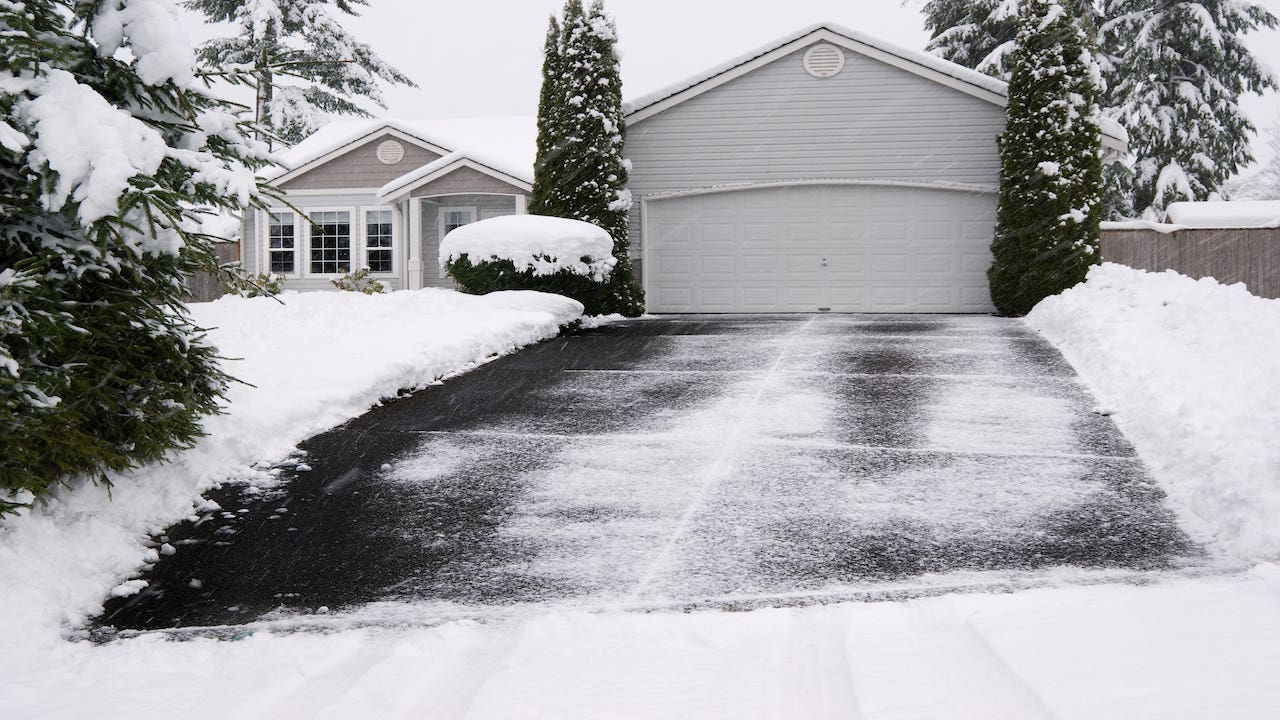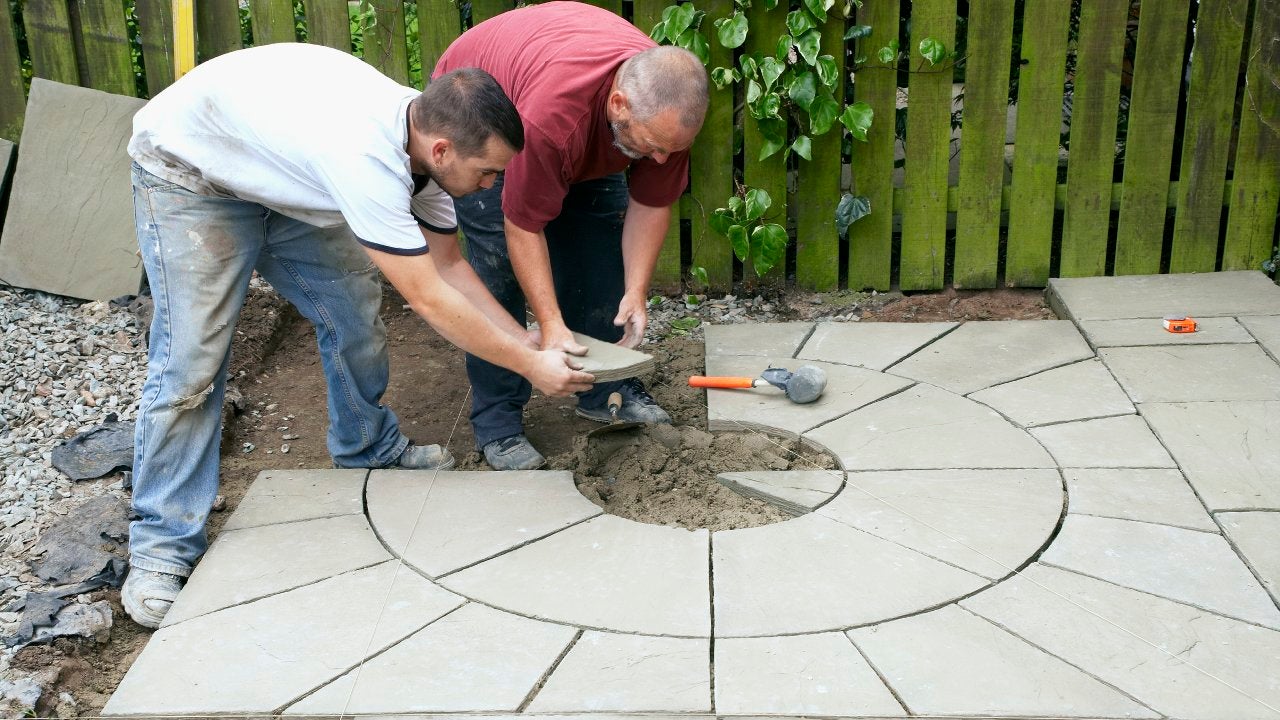How do you heat a driveway?

Come winter, do you dread waking up to find your driveway covered in snow or ice? Consider installing a heated driveway. Such a system makes it easy to drive in and out of your property, helps prevent slip-and-fall injuries and saves you from a tedious, time-consuming task.
But installing a heated driveway system isn’t easy, and it’s not cheap, either. Let’s look at how they work, what they cost and factors that can influence the price — all to help you decide if it’s worth it to heat your driveway.
What is a heated driveway?
A heated driveway is a system designed to melt ice and snow on driveways and adjacent pathways, and prevent it from building up. It operates by using either hydronic or electric heat, and the system can either be automatically or manually activated.
The benefits of having a heated driveway installed include:
- Saving you the time and effort of manual shoveling or snow plowing
- Decreasing the risk of injury to you and your car
- Preventing the formation of ice dams, which can damage the driveway via potholes or cracks
- Reducing the corrosive effects of salt or de-icing chemicals on your driveway surface
- Prolonging the lifespan of your driveway by preventing the accumulation of ice and snow, which expands and contracts – causing stress and cracking over many freeze-thaw cycles.
Among the disadvantages of implementing a heated driveway are:
- High installation costs for materials and labor
- Higher utility bills associated with heating the driveway via electricity, natural gas or another fuel
- Need for and expense of inspections, maintenance and repairs
- Limited lifespan: Heated driveways typically last anywhere between 15 and 20 years before they need to be replaced
What are the different types of heated driveways and how do they work?
The two primary means of a driveway are similar to the methods used for heated floors inside a home: hydronic and electric.
Hydronic heating
Hydronic heated driveways employ radiant heat via flexible polymer (PEX) tubing installed beneath the driveway surface that circulates water and antifreeze liquid, heated to a consistently warm temperature via a boiler or water heater commonly housed nearby (such as in the garage). “Hydronic driveways are more complicated to install and maintain, but they can heat up snow and ice quickly,” explains Mallory Micetich, a home expert with Angi.
Glycol is often used in the antifreeze mixture, which also protects the system’s pipes from damage. Hydronic systems are preferred for areas with extremely cold climates.
Electric heating
Electric heated driveways employ an enmeshed grid of mats and cables or coils, placed beneath the driveway surface to warm up the surface using electricity.
“When activated, the electrical current passes through the wires, generating heat that transfers to the driveway, melting snow and ice,” says Duane Draughon, president of VizX Design Studios, an outdoor living design firm that specializes in heated driveway installations. “These systems are usually less effective at melting snow and ice than hydronic systems heated via a boiler.” They are also less energy-efficient than hydronic heated driveways, costing more to run — though some use solar power nowadays.
However, electrically heated driveways are often less expensive and easier to install, especially under existing surfaces, and less vulnerable to corrosion and damage.
Another option is “pre-made portable heated driveway mats that the homeowner spreads over the existing pavement and plugs into an outlet for power when needed,” says Daniel Sarrero, co-owner of SEA Concrete Contractors, which also installs heated driveways. Obviously, these gigantic heating pads are going to be cheaper than a built-in system, but many folks find them unsightly, and there’s also the drag of laying them down and picking them up.
Automatic vs manual systems
Built-in heated driveways systems traditionally work with a flip of the switch: You turn them on when the snow or sleet starts. But now there are “automatic heated driveways [that] use sensors to detect when temperatures drop below freezing and automatically turn on the system as needed,” Sarrero explains.
An automatic system will cost more to install — about $250 to $600 more than the manual variety — and will probably run up higher energy bills, since the sensors could activate the system sooner and keep it on longer than you might. But the automation can be handy if there’s a storm overnight or while you’re on a trip.
How much do heated driveways cost?
On average, it costs $3,900 to install a heated under-pavement driveway system, according to Micetich, within a range of $1,300 to $7,500.
“You can expect to pay between $12 and $21 per square foot to install a heated driveway, depending on the type and material of the driveway,” she continues. “The cost will be higher, however, if you need to retrofit or remove an old driveway first. Expect to pay an extra $1 to $2 per square foot in this case.”
In other words, it’s a lot easier and less expensive to install a hydronic or electric-heated driveway system beneath a new/yet-to-be-paved driveway. If you want to retrofit your existing driveway (more on this later), the price and effort go up substantially.
A portable plug-in electric mat that you lay on the driveway surface can be much less expensive; count on paying between $30 to $45 per square foot, on average.
What factors influence the cost of a heated driveway?
Your price tag for an installed heated driveway system will vary, depending on several factors.
System/method type
Radiant electrical systems run about one-third to one-half the cost of hydronic systems, which could require additional plumbing and equipment (boilers, water heaters).
“Hydronic heating systems are great at melting snow and ice quickly, but they can be expensive to install. Electric heating systems are less costly upfront but may have higher operating costs than hydronic systems,” says Micetich — especially if electricity is expensive in your area.
Length/shape
The shape and length of your driveway will also play a role in what you pay.
“Longer driveways require more materials and labor, resulting in higher expenses. Complex shapes or irregular layouts may also increase installation complexity and costs,” adds Draughon.
New vs retrofit
While it’s possible to install a heated system beneath an existing driveway, it’s more challenging and typically more expensive than if you implemented the system beneath a yet-to-be-built one.
Still, retrofitting a current driveway is possible. A contractor can saw-cut through the asphalt, concrete or other material to create thin channels through which the heat cables are laid, then covered. A real pro can conceal the addition pretty well, but you may still be left with some visible tracks on the driveway. Or, cables can be laid on top of the existing surface, then topped by a new layer of asphalt or concrete (it generally works better with asphalt). If you have a paver driveway, the stones or bricks can be removed, the heating system laid down on a sand bed, then the stones replaced.
Driveway material: asphalt vs concrete vs pavers
Unless you’re opting for the simple surface mat method, you have to replace or repair the driveway torn up for the heating system. Or of course install it in the first place. Either way, the material you choose makes a difference.
“On average, heated asphalt driveways cost around $8,600 to install. Asphalt is a great option for people who live in extremely cold climates because it doesn’t tend to crack in cold temperatures,” says Micetich. “Concrete is another popular choice for heated driveways, costing an average of $7,550 to install. Concrete tends to crack in cold temperatures, but it can last longer in the right conditions.”
Paver driveways, on the other hand, tend to be more expensive — up to $30,400 due to the cost of materials and the additional labor required. But they can be easier to retrofit.
Design features
Patterns, borders, customizations and other design features can significantly affect the driveway’s price, too. “Intricate designs or unique features may require additional materials and labor, leading to increased expenses,” Draughon cautions.
Labor
Driveway material will comprise a substantial portion of the budget, but so will labor costs. These can vary depending on your location, the size and shape of the driveway and complexity of the installation. In general, driveway installation projects (including heated ones) boil down to about 40 percent for the workers vs 60 percent for material and equipment.
Is it worth it to heat a driveway?
Considering the effort and expense involved, it’s important to weigh the pros and cons carefully before committing to a heated driveway installation.
“The worth of investing in a heated driveway will depend on your individual preferences, climate conditions and budget,” suggests Phil Sarros, a professional landscaper and construction industry consultant based in Cumming, Georgia. “Ongoing costs may include electricity or fuel for heating, periodic maintenance and potential repairs. And while a heated driveway can enhance your property’s value and appeal, the exact return on investment can vary.” Not every buyer may want the extra energy bills — the average annual operating cost runs $120 to $600, with electric driveways on the higher end — or (occasional) inspection/upkeep responsibilities.
Admittedly, it’s a luxury. Still, weather conditions are getting more extreme, and paying someone to clear a driveway can be costly too. So can tow trucks and auto repair bills, if your car runs off a slippery driveway and into a tree or fence.
“Consult with a contracting professional and try to conduct a cost-benefit analysis,” advises Draughon. The more often you have to deal with snow and ice and the more limited you are physically, the more you will benefit from installing a heated driveway.
You may also like

Recoverable depreciation in home insurance: What it is and how it works


Why buying a car in winter is a smart move

How much does it cost to install a concrete patio?


